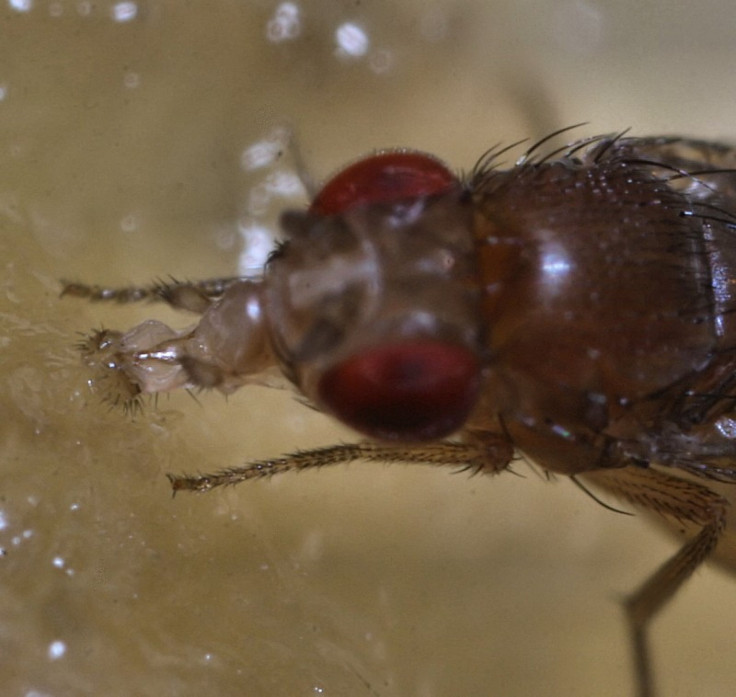Fly Mutations Offer Quicker Clues To Human Diseases

Scientists have long used mutations in fruit flies, worms and mice as tools to identify genes associated with diseases in humans, but the path from animal to human often takes years.
But a collaboration between Baylor College of Medicine scientists studying fruit flies and Canadian human genetics researchers linked a gene that caused neurodegeneration in flies to a human disease called autosomal recessive spastic ataxia with frequent leukoencephalopathy, or ARSAL, in a matter of months, according to a study published Tuesday in PLoS Biology.
While the discovery of mutations in fly genes has been linked to human disease before, it has often taken many years to decades to accomplish this, Hugo Bellen, developmental biologist at Baylor College of Medicine and senior author, said in a statement.
John Manak, a biologist at the University of Iowa unaffiliated with the study, estimates that about 75 percent of genes related to human diseases and cancer are conserved in flies.
The fly model of a human disease is powerful, Manak says, because not only can we readily do genetic screens to identify other genes in the disease pathway, but we can also start screening drugs in the fly.
Manak uses fruit fly models to study epilepsy. In a January 2011 paper published in the American Society for Human Genetics, his team reported that mutations in similar genes can cause seizures in mice, flies and humans. They also discovered that the fruit flies suffering seizures are responsive to human anti-epileptic medication.
The latest connection between fruit flies and humans began when Hugo Bellen's lab at Baylor started to find genes in the fruit fly that, when mutated, caused the photoreceptor cells of the flies' eyes to deteriorate.
We were trying to use the fly to study basic mechanisms of disease, Bellen said.
Bellen's lab induced random mutations in certain fly genes and created flies that had patches of tissue expressing the mutation in their eyes. (They couldn't make the entire fly a mutant, because many of these mutations are homozygous lethal, meaning that a full dose of the mutated gene is deadly.)
To find the mutations linked to neurodegeneration, the Baylor scientists looked for flies that started out relatively normal, but whose eyes grew worse with age. They found one particular mutation in a gene called Aats-met, which encodes for an enzyme in the mitochondria, the power plant of the cell.
Flies with Aats-met mutations had, in addition to degenerated retinas, shorter lifespans. Their flight muscles quickly grew weak. The flaws even went down to the sub-cellular level; Bellen's team found that the mitochondria of the mutated flies were not able to process oxygen as well as the mitochondria of normal flies.
The Baylor scientists knew that mitochondrial defects are associated with a number of human neurological diseases, and that many fly genes have close analogues in humans.
So they made a call.
We were contacted by Bellen's group, and they were saying, 'we have this interesting fly gene, could you look at it?' says Bernard Brais of the Montreal Neurological Institute of McGill University, another author on the PLoS Biology paper.
A few years earlier, Brais and his colleagues had identified a region of the human genome linked to ARSAL, which causes sufferers to become uncoordinated and, in many cases, lose the ability to walk. But Brais' team didn't know exactly what gene was responsible for the disease.
The fly team pointed the Canadian researchers to MARS2, the human version of Aats-met. Soon, Isabelle Thiffault, another McGill researcher, identified strange mutations in the MARS2 genes of the ARSAL patients. The affected people also had lower levels of the MARS2 enzyme than normal and impaired mitochondrial function, just like the flies.
The ARSAL patients' cells also had higher levels of reactive oxygen species, molecules formed as a byproduct of mitochondrial respiration that can damage cells and genetic material.
There's much more work to do - the scientists still don't know if the MARS2 mutation is present in every cell, or only in certain types of cells. Further studies of the MARS2 mutation in animals will be complicated - the gene doesn't have an analogue in mice, and the mutation in the Aats-met flies is much less complex than the MARS2 mutation in the human patients.
Since the roots of many human diseases are preserved in flies and they're a cost-effective way to test for candidate drugs, is collaboration between human disease researchers and fly geneticists a booming field?
The answer, unfortunately, is that it's surprisingly less common than you might imagine, Manak says. I think the reason that's the case is that oftentimes people don't know how to model a specific human disease in flies.
What's hard, he says, is figuring out which behavior or characteristic of the fly relates to the human disease of interest. A fly can exhibit seizure-like activities such as uncoordinated muscle movements, but more complex disorders are harder to characterize.
In short, it's easier to tell if a fly is epileptic than if it is schizophrenic.
But Manak is optimistic - he says he and his team are working on fly versions of genes associated with human schizophrenia, and they're seeing abnormal social behavior in the mutated flies.
Modeling complex disorders directly in flies is hard, but I'm going to bet we'll be able to do that quite soon, Manak says.
© Copyright IBTimes 2024. All rights reserved.




















